Model:Cycles review: An affordable and approachable FM groovebox
Elektron expands its entry level lineup with a $299 take on its popular Digitone synth.
Fair or not, Elektron has a reputation for making complex and kinda pricey electronic music gear. Last year though, it made a serious play for the entry level with the Model:Samples ($299), an affordable, sample-based groovebox that simplified Elektron's unique workflow for beginners. In a lot of ways, it's a stripped-down version of the company's Digitakt sampler. If you're familiar with the Digitakt, you've no doubt often seen it paired with the Digitone, a sort of sibling groovebox that relies on FM synthesis instead of samples. So it only makes sense that Elektron would want to give the Model:Samples its own FM-based partner in crime.
Physically the Model:Cycles is basically a palette-swapped version of the Model:Samples -- Subzero to the M:S' Scorpion. At its core it's the same six-track monophonic sequencer -- but with a streamlined version of the Digitone's sound engine under the hood. Obviously though sacrifices had to be made to hit that $299 price point. As a result, the Cycles isn't exactly a budget-friendly replacement for the Digitone. It's very much its own instrument.
Before we get too far though, let's pause and talk about FM synthesis. I'm not going to spend too much time explaining how it works. Frankly, plenty of people have already done that better than I probably could. But if you're new to it, there are a few things to keep in mind and some terms to nail down.
First up, an operator is just an oscillator with another name. The difference between an oscillator in subtractive synthesis and an operator in FM is simply that an operator doesn't necessarily produce a sound and can instead be used to modulate another operator. An operator that makes a sound is called a carrier. An operator that modifies the carrier is called a modulator. And how your various operators are combined and interact with one another is called an algorithm.
FM is also known for being difficult to program, though this is in large part due to the Yamaha DX7. The DX7 is probably the most famous FM synth, and it's literally the sound of the '80s. It featured six operators that could be combined through 32 different algorithms. And most of its controls were hidden behind a cumbersome menu system.
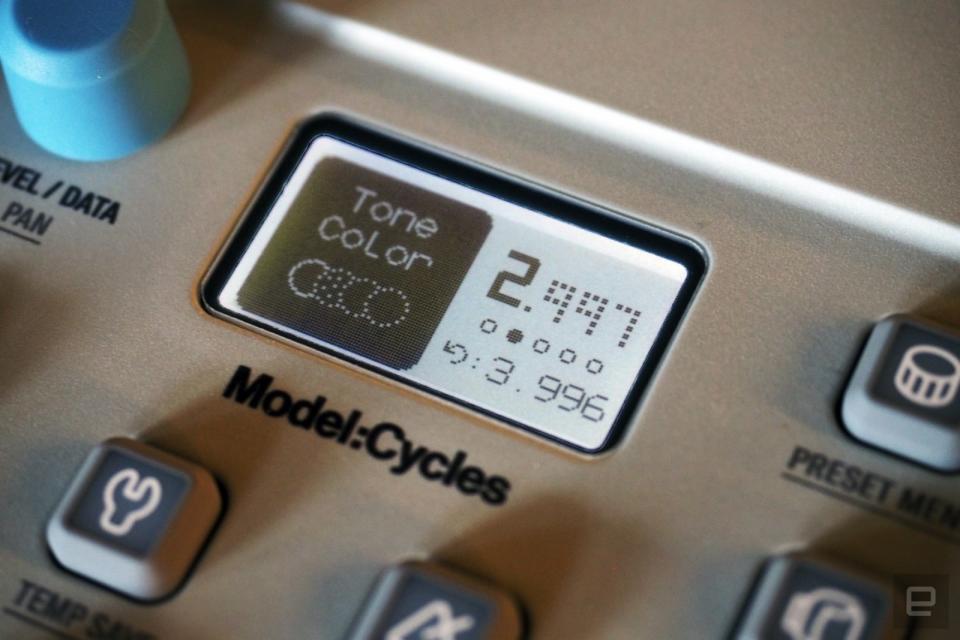
Not all FM synths are that complicated though. The Digitone does a surprisingly good job of simplifying the sound-design process. Its four operator engine and eight algorithms are streamlined to focus primarily on the more musical side of FM and less on its knack for abrasive and chaotic sounds. The Model:Cycles takes this further by hiding even more of the sound-sculpting options behind vague terms like "color" and "contour."
The whole sound-design process starts with picking a "machine." This is essentially the equivalent of an algorithm on any other FM synth, except here each machine has been given a name that helps you identify what it's best suited for (and each has adorable RPG-style stat cards). There are Kick, Snare, Metal, Perc, Tone and Chord. Then, depending on what machine you've chosen, the color, shape, sweep and contour knobs all control different parameters. For instance, in the Tone machine, "color" changes the modulator ratio (the frequency of the modulator as expressed in a ratio to the carrier), while in Snare it controls the number of inharmonic frequencies.
These machine names are merely suggestions though. Even with the limited controls available to you, it's pretty easy to take Metal (which is described as a "sweetspot-laden metallic voice for all your cymbal needs"), and turn it into an abrasive distorted pad or Perc (short for percussion) and mutate it into a plucky lead.

There are also two other options on the front panel that are unique to the Cycles: punch and gate. These are simple on and off buttons, but they dramatically change the behavior of your sound. "Gate" simply means the note you play will be held until you release the pad or trig key, essential for sustained chords or leads, while "punch" adds a pseudo compressor and some distortion. This is a good way to add a little grit and bite to a sound without having to rely on the normal FM dissonance.
Before you start messing around designing your own sounds though, it's worth quickly checking out the stock patterns and presets to give you an idea of what the machine is capable of. There are 32 patterns already loaded in the first project for you to explore that cover everything from drum and bass to trap, chiptune, dub and IDM. And the 512 preset sounds give you claps, leads, chords, rimshots, et cetera -- basically, anything you need to start sketching out your own tracks.
Poking around at these is also a good way to get familiar with the performative aspects of the Model:Cycles. Like the Model:Samples, this is a largely knob-per-function experience. There are velocity-sensitive pads with aftertouch for each track, 16 trig keys for step sequencing or playing sounds in chromatic mode, a retrig button, a fill button, and 14 knobs to twist and turn as you explore the limits of each pattern. Plus there's a control-all button that allows you to quickly mangle your creation before reverting it back to its original state by pressing function and pattern.
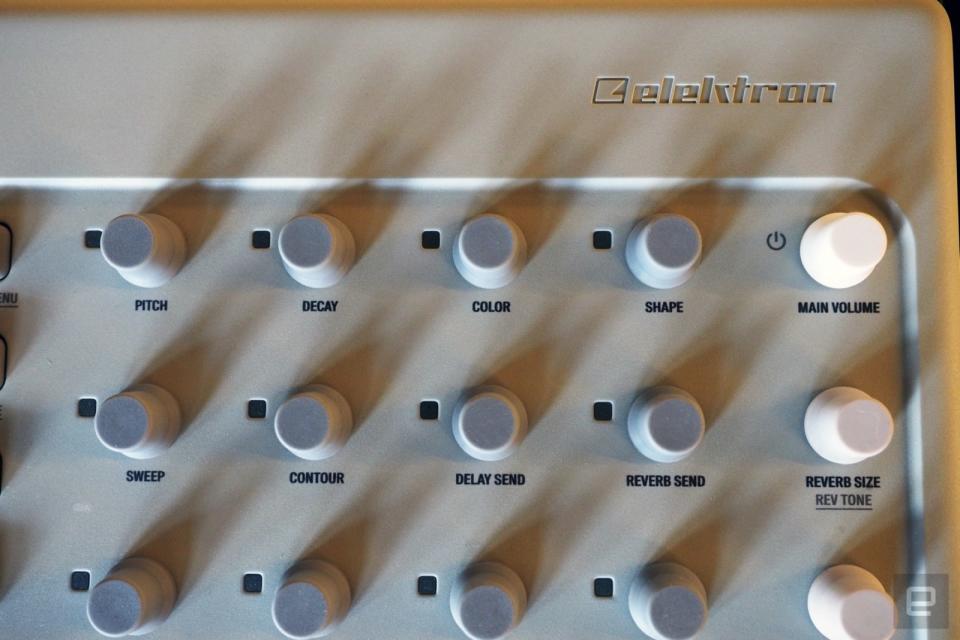
Also like the Samples, and unlike some of Elektron's more expensive gear, the Model:Cycles is hands-on with almost no menu diving. Coming to grips with playing it live is a core part of the Models experience, especially when you're talking about that control-all function. It's a powerful tool when wielded properly -- but it's also easy to turn your masterpiece into an unrecognizable and unmusical mess if you're not careful.
For the most part, playing Model:Cycles is just like playing the Model:Samples. The core controls are all the same. The UI is the same. And the sequencer is the same -- and still incredible. Honestly, of all the features that you'd want the company to make available in its entry-level products, it's the sequencer.
The 64-step Elektron sequencer has a number of features that make it unique. For one, there are what it calls parameter locks. That means that every step on a track can have completely different settings. Many sequencers have a similar feature, but the Elektron implementation is particularly powerful because basically any and all parameters can be locked with almost no limitations. That includes everything from the decay to the amount of reverb to the speed of the LFO or what it's applied to. Even the machine or preset can be changed on a per-step basis. This is super handy for making the most of the six tracks, since you can do things like put your bass drum and snare on the same track if they're not going to hit at the same time.
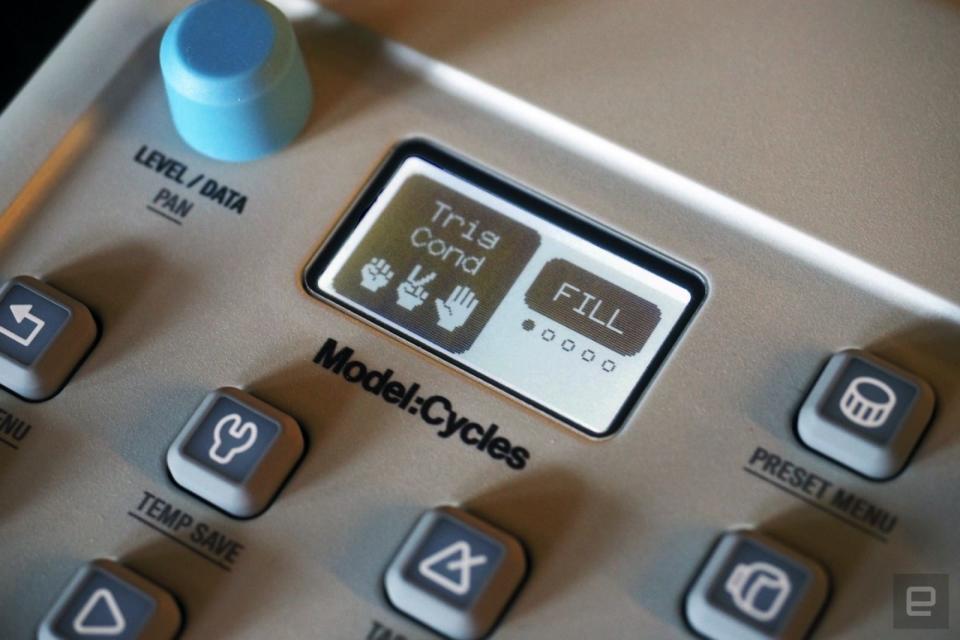
There are also trig conditions: These are rules that govern when a step is played. The most basic example is adding a snare roll that only plays when you press the fill button. But the more interesting options are the probability and ratios. These allow you to extend the life of a simple four-bar loop by injecting a bit of unpredictability. You can set an extra kick drum to play 33 percent of the time or every second time through a pattern. Or you can build an elaborate set of conditions that relies on the outcomes of other trig conditions. For example, you could set a short synth melody to play 15 percent of the time. That could trigger a response line from the bass, which then causes the hi hats to play in double time and the bass drum to drop out.
It's surprisingly powerful and complex for something that is squarely entry level. To be fair, the same was true of the Model:Samples when it was released last year, but now that the price has dropped from $399 to $299 for the Models lineup, it's even more intriguing. There isn't anything else quite like the Cycles in this price range.
Novation's Circuit is perhaps its closest competitor. It's a $330 groovebox that has legions of fans thanks to its versatile design and affordable price. Its four drum parts and two synth parts are a little more prescriptive than what the Cycles' offer, but its two synths are polyphonic, and it can be loaded with 60 seconds of samples. It has a much larger selection of effects too: 16 delays, eight reverbs, seven sidechaining effects and a multimode filter. That's quite a lot compared to the Cycles' single delay and reverb options.
The Circuit can also be powered by a handful of AA batteries. When the Model:Samples was released last year, Elektron said it was working on a battery handle for the device (and by extension the Model:Cycles). But it's a year later and we still don't know when that will arrive or how much it will cost. You can buy a cheap adapter off Amazon and use any standard USB battery pack with the Model instruments. But it's not exactly ideal.
Update 2/26/2020 5pm ET: Well, at least we know what the battery handle will look like and how much it will cost now. Sadly we still have no idea when it will be released. Shortly after announcing the Model:Cycles Elektron published a placeholder page for the Power Handle BP-1. It will be $39 when it is eventually released at a "later date."
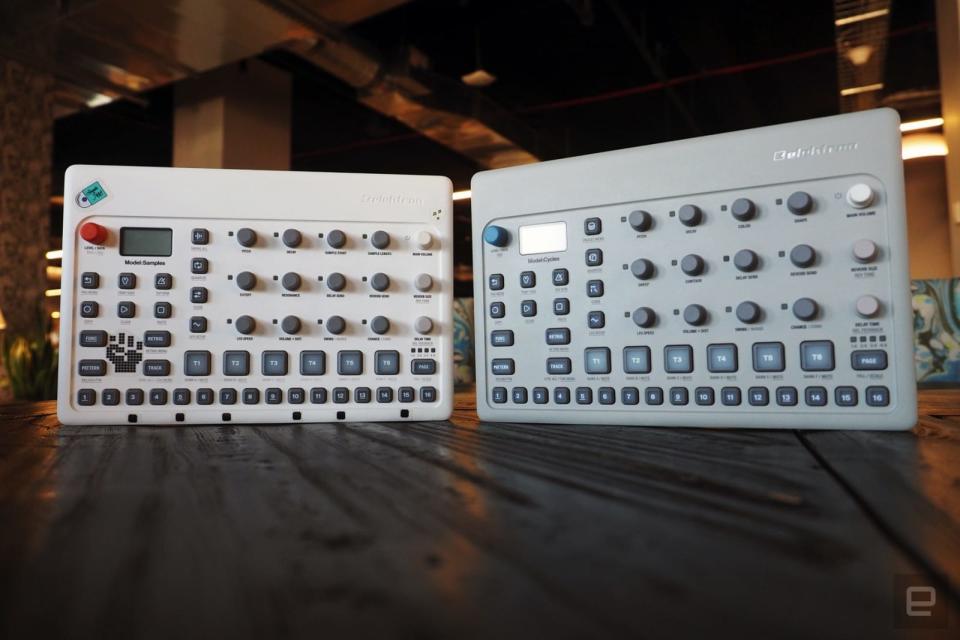
Honestly, the decision you're more likely to be making is between Elektron's various devices. If you want a rich and unique FM experience and have the money to spare, go straight for the $749 Digitone. It's more of a traditional synth than a groovebox, but its features and sound-sculpting capabilities are far beyond what the Model:Cycles offers. Its filters (more often associated with subtractive synthesis) and arpeggiator, in particular, would have been welcome additions to the Cycles. Maybe Elektron will find a way to add those via a future software update.
Then there's the Model:Samples. It's still an incredibly fun and creative instrument. But choosing between the two (Elektron would tell you to buy both) is a relatively simple endeavor. If you prefer to work with samples, choose the Model:Samples. If you'd rather build tracks around a proper synth engine, get the Model:Cycles.
To give credit where it's due, Elektron clearly learned a thing or two over the past year. I have seen some complaints online about the build quality of the Samples, including reports of buttons coming off. And one of the trig keys on our review unit has gotten stuck once. But the Cycles feels more polished and solid than the Samples ever did. It's a subtle difference, but the buttons feel more secure, and the resistance on the encoders has been fine tuned. However, the pads are as underwhelming as ever. They take way too much force to get full velocity out of, and regardless of how much tweaking I did, I could never get a satisfying amount of depth out of them.
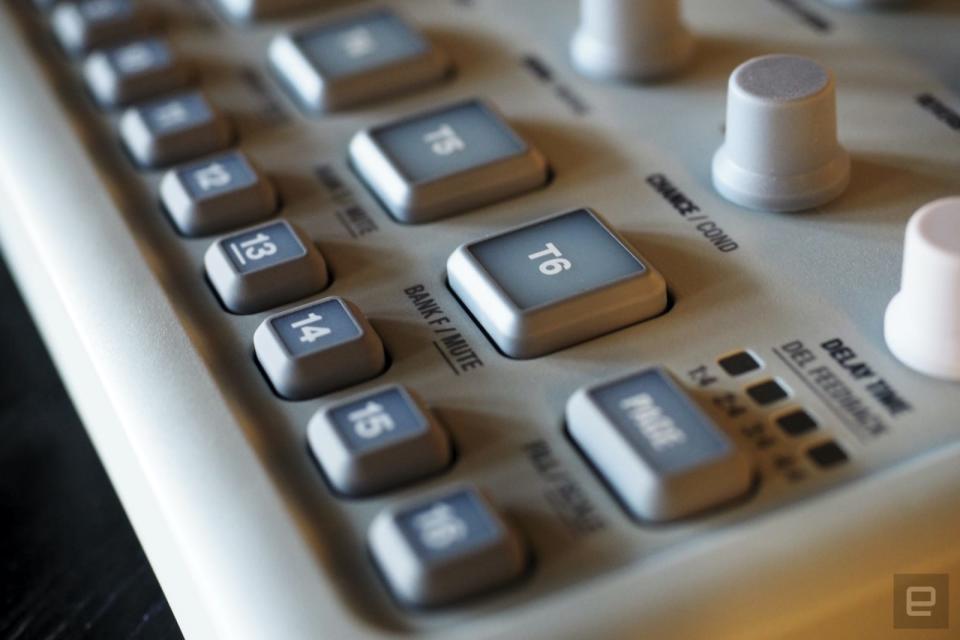
There are also a few welcome refinements to the feature set. For one, the Cycles has much more fine-grained control over pitch. The Samples only operated in semitones, which can be a huge problem if you're working with a melodic sample that's slightly out of tune.
The Cycles also adds velocity as a modulation source -- though I really wish Elektron would have included aftertouch here. Being able to change the "shape" of a sound based on how hard you hit a pad is great, but being able to continue to morph it after the initial strike would add a lot more dimension. This does mean that if you hook up an external MIDI keyboard, you can milk a bit more expressiveness out of the synth sounds without having to manually dial in velocity.
That extra source of modulation is useful, since for some reason Elektron still didn't include a standard ADSR (attack, decay, sustain, release) envelope. That means if you want to create a slowly rising pad, you have to use the lone LFO to control the volume instead of, say, modulating the contour. (Quick aside: would be great if you could chose velocity as a modulation destination, too.) With the Model:Samples, the lack of an envelope was annoying but understandable. On a more synthesis-focused instrument, it's a questionable choice.
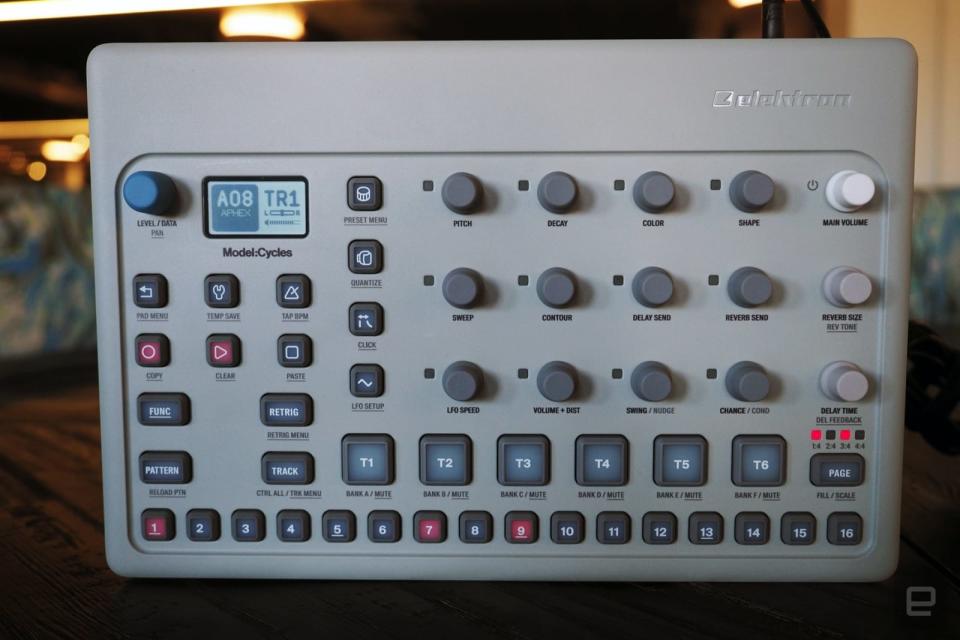
Those gripes aside, I can't help but be enamored with the Model:Cycles. The sound engine inside is great. It takes a little work to ring the most out of it, but it's versatile for an FM synth. And the Elektron sequencer remains second to none. Is this the budget-friendly Digitone I've been dreaming of? No. The two share a lot of aural DNA, but the Cycles is much more of a true groovebox and lacks polyphony. That being said, it's a powerful and creative instrument in its own right. More important, it's every bit as fun to play as the Model:Samples. Oh, and at just $299, it's basically the most affordable full-featured groovebox you can get.
PRODUCT SPECS
6 × FM-based Machines
1 × Assignable LFO per track
1 × Assignable velocity modulation per track
Delay and reverb send FX
64 step sequencer with unique length and scale settings per track
Real-time or grid recording of notes and parameters
6 × Audio tracks (all of which may be used as MIDI tracks as well
Parameter locks
Micro timing
Trig conditions
Assignable retrig
6 × Velocity sensitive pads
Class compliant USB audio 2.0
1 × 1/4″ Headphones output
2 × 1/4″ Balanced main outputs
1 × Hi-speed (micro) USB 2.0 port (MIDI and audio)
3.5 mm dual polarity TRS MIDI In, Out/Thru jacks
2 × MIDI adapter (5-pin DIN to 3.5mm TRS minijack)
48 kHz, 24-bit D/A converters
Storage space for up to 60,000 presets
96 Projects
96 Patterns per Project

